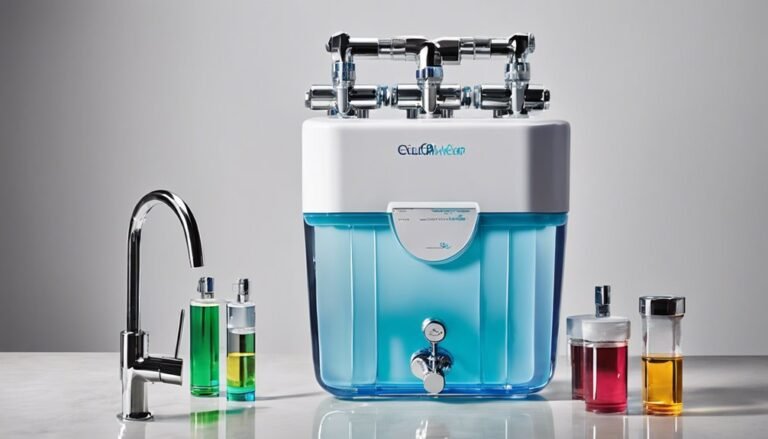What Is Grain in Water Softner?
When you're evaluating the quality of your water, the term "grain" often comes up, but what does it really mean in the context of a water softener? Fundamentally, grain quantifies the hardness minerals in your water, primarily calcium and magnesium, influencing how effectively your softener can perform. Understanding this measurement is vital, especially when selecting a system that meets your household's needs. Yet, many people overlook the implications of grain levels. So, how do these measurements affect your water quality and the performance of your softener?
Key Takeaways
- Grain measures the amount of dissolved hardness minerals, primarily calcium and magnesium, in water, typically quantified in grains per gallon (gpg).
- One grain per gallon equals approximately 17.1 parts per million (ppm) of water hardness, helping assess water quality.
- Water softeners use grain capacity to indicate how much hardness can be removed before regeneration is required.
- Different types of resin grains are used in softeners, affecting their efficiency in removing hardness from water.
- Understanding grain measurements helps in selecting the right water softener for optimal performance and maintenance.
Definition of Grain
What exactly does "grain" mean in the context of water softeners? In technical terms, a grain is a unit of measurement that quantifies the amount of dissolved minerals, primarily calcium and magnesium, present in the water.
When discussing water hardness, understanding the grain measurement provides definition clarity about how hard or soft your water is. Specifically, one grain per gallon (gpg) equates to approximately 17.1 parts per million (ppm) of hardness.
As a result, if your water tests at 10 gpg, it contains 10 grains of hardness per gallon, translating to about 171 ppm. This measurement helps you determine the effectiveness of your water softener.
Most water softeners are rated based on their capacity to remove grains of hardness. For example, a softener with a capacity of 30,000 grains can effectively soften water until it reaches that threshold.
Once it hits that limit, you'll need to regenerate the system, restoring its ability to remove hardness. Understanding grain measurement is essential for maintaining peak performance and ensuring you get the best results from your water softening system.
Importance of Water Hardness
Understanding the importance of water hardness is crucial for both your home's plumbing system and your overall water quality. When water hardness levels are unbalanced, several issues can arise that affect both functionality and health.
- Plumbing Damage: Hard water leads to mineral buildup in your pipes, which can reduce water flow and increase pressure on your plumbing system. This buildup can cause leaks and costly repairs.
- Appliance Lifespan: Appliances like dishwashers and water heaters can experience decreased efficiency and a shorter lifespan when exposed to hard water. Scaling from minerals may hinder their functionality, leading to premature replacements.
- Health Effects: While hard water isn't inherently harmful, it can interact with soap and detergents, making it difficult to wash away contaminants. This can affect your skin and hair quality, as well as the overall water quality for drinking and cooking.
Recognizing these factors helps you appreciate the significance of managing water hardness. By understanding its implications, you can make informed decisions for your home, ensuring a healthier living environment and extending the life of your plumbing and appliances.
How Grains Are Measured
Measuring grains in water softeners is vital for determining water hardness and the appropriate level of treatment needed. To assess the hardness of your water, you typically start with a grain measurement, which quantifies the amount of calcium and magnesium in grains per gallon (gpg). One grain of hardness is equivalent to one grain of calcium carbonate dissolved in a gallon of water.
To perform the measurement, you can use a water hardness test kit that provides results in gpg. This data allows you to understand how hard your water is and informs your decisions regarding softening requirements.
If you need to convert grain measurements, be aware that 1 gpg translates to approximately 17.1 parts per million (ppm) of calcium carbonate.
For practical applications, knowing how to perform grain conversion is important. This guarantees that you can effectively communicate your water hardness levels when discussing treatment options with professionals or when selecting the right water softener for your needs.
Keep these measurements and conversions in mind to maintain the best water quality in your home.
Effects of Hard Water
How does hard water impact your daily life? You mightn't realize it, but the minerals in hard water—like calcium and magnesium—can have significant effects. Here are three critical areas where hard water can affect you:
- Skin and Hair Health: Hard water can cause dry skin and hair. The minerals in the water can strip natural oils, leading to irritation or exacerbating conditions like eczema.
- Appliance Efficiency: Hard water leads to scale buildup in appliances like dishwashers and water heaters. This not only reduces their efficiency but can also shorten their lifespan, costing you more in repairs and replacements.
- Cleaning Effectiveness: You may notice that soap doesn't lather as well in hard water. This means you might use more detergent, leading to higher expenses and less effective cleaning.
While hard water is generally not harmful to your health, it can contribute to discomfort and increased costs.
Understanding these effects can help you make informed decisions about water treatment options, ensuring a better quality of life in your home.
Water Softener Capacity
To effectively choose a water softener, you need to understand its grain capacity, which indicates how much hardness it can remove before regeneration is required.
Calculating your household's water needs will help you select a system that meets your demand without frequent regeneration.
This balance impacts both efficiency and operational costs, making it essential to factor in your water usage patterns.
Understanding Grain Capacity
When selecting a water softener, understanding grain capacity is vital for ensuring effective performance. Grain capacity refers to the amount of hardness minerals a water softener can remove before it requires regeneration. This capacity is typically measured in grains.
To make an informed choice, consider the following three factors:
- Grain Types: Different water softeners are designed to handle various grain types, such as sodium or potassium. Knowing which type suits your water chemistry is important for ideal performance.
- Grain Efficiency: Look for water softeners that maximize grain efficiency. This refers to the ability to remove the most hardness minerals with the least amount of salt or potassium used during regeneration. A more efficient system saves you money and reduces environmental impact.
- Household Water Usage: Assess your household's water consumption to determine the grain capacity you need. Higher usage means you'll require a unit with a greater grain capacity to maintain soft water consistently.
Calculating Water Needs
Calculating your water needs is essential for selecting the right water softener capacity to guarantee peak performance. Start by evaluating your household usage. Determine the total daily water consumption by considering the number of people in your home and their average water usage. On average, a person uses about 80-100 gallons of water per day. Multiply this figure by the number of people in your household to get a baseline estimate.
Next, factor in the hardness of your water, which is measured in grains per gallon (gpg). You'll want to know the grain level to adjust your softener's capacity accordingly. For example, if your household consumes 400 gallons of water daily and your water hardness is 10 gpg, your water softener will need to handle 4,000 grains of hardness each day (400 gallons x 10 gpg).
Consider any additional water-consuming appliances, such as dishwashers or washing machines, which might increase your overall water consumption.
Regeneration Frequency Impact
The frequency of regeneration in a water softener considerably affects its overall capacity and efficiency. By optimizing the regeneration cycle, you can guarantee that the system operates at peak performance, providing you with softer water when you need it most.
Here are three critical factors to take into account for effective frequency optimization:
- Water Hardness Levels: The greater the hardness of your water, the more frequent the regeneration cycles will need to be. Higher hardness levels require additional salt and more frequent regeneration to maintain capacity.
- Water Usage Patterns: If your household has fluctuating water needs, adjust the regeneration frequency accordingly. For example, if you use more water during certain times of the day, a more frequent cycle may be necessary during peak usage.
- Salt Efficiency: Frequent regeneration cycles can lead to increased salt consumption. Balancing the frequency guarantees you're not wasting resources while still maintaining water softness.
Choosing the Right Softener
When choosing the right water softener, it's essential to understand the types of softener grains available and how grain sizing impacts performance.
You'll need to take into account factors like water hardness and your household's water usage to determine the most effective grain type for your system.
Selecting the appropriate grain size can greatly enhance the efficiency and longevity of your water softening solution.
Types of Softener Grains
Choosing the right softener grains can greatly impact your water quality and system efficiency. When selecting grains, it's important to understand the different types available and how they relate to resin materials.
Here are three common types of softener grains:
- Cation Exchange Resin: This is the most widely used grain type. It effectively removes calcium and magnesium ions, replacing them with sodium ions. This resin is vital for various softener types.
- Anion Exchange Resin: While less common in residential applications, this type targets negatively charged contaminants like nitrates and sulfates. If you have specific water quality issues, consider this resin as part of your system.
- Mixed Bed Resin: This combination of cation and anion exchange resins provides thorough purification. It's often used in applications requiring high-purity water, such as in laboratories or industrial settings.
Grain Sizing Considerations
Selecting the right grain size for your water softener is vital for optimizing its performance and efficiency. The grain size directly impacts how well the softener can remove hardness minerals from your water. When considering grain distribution, it's important to choose a size that complements your specific water conditions and the softener's design.
Here's a simple comparison of common grain sizes and their applications:
| Grain Size (mm) | Recommended Use |
|---|---|
| 0.5 – 1.0 | Residential systems |
| 1.0 – 2.0 | Commercial systems |
| 2.0 – 4.0 | Industrial applications |
Each grain size offers different benefits. Smaller grains provide a larger surface area for ion exchange, which can be beneficial in residential systems where water hardness is moderate. In contrast, larger grains are often preferred in commercial and industrial settings due to their flow rates and durability.
Selecting the ideal grain size and ensuring proper grain distribution will help you achieve the best results from your water softener, enhancing both its lifespan and effectiveness.
Maintenance and Regeneration
A water softener's efficiency hinges on regular maintenance and timely regeneration cycles. Proper adherence to these processes guarantees peak performance and longevity.
Here are some essential maintenance tips to keep your system running smoothly:
- Check Salt Levels: Regularly inspect the brine tank and maintain adequate salt levels. Ideally, the salt should be at least 1/3 full to guarantee effective regeneration.
- Clean the System: Periodically clean the resin bed and brine tank. This helps prevent buildup that can clog the system and hinder the regeneration process.
- Monitor Water Usage: Keep an eye on your water consumption patterns. Adjust the regeneration frequency based on your household's water usage to confirm you're not over or under regenerating.
The regeneration process is crucial for recharging the resin beads that remove hardness from water. Depending on your unit, this can be initiated manually or programmed to occur automatically.
Benefits of Softened Water
Softened water consistently offers numerous advantages that enhance both household comfort and appliance longevity.
One of the most notable softened water benefits is its ability to reduce scale buildup in plumbing and appliances. This means your water heater, dishwasher, and washing machine will operate more efficiently, ultimately extending their lifespan and reducing maintenance costs.
Moreover, softened water can greatly improve your skin. Hard water often contains minerals that can exacerbate dryness and irritation; by switching to softened water, you can experience fewer skin issues.
You'll notice that soaps and shampoos lather better, requiring less product and leading to softer, healthier skin after washing.
Additionally, using softened water can enhance your laundry process. Clothes washed in softened water come out cleaner and feel softer, as the absence of harsh minerals prevents residue buildup.
This not only improves the texture of your fabrics but also prolongs their life.
Frequently Asked Questions
Can Grain Levels Affect My Home's Plumbing System?
Yes, grain levels can considerably impact your home's plumbing system. Higher levels may lead to reduced softener efficiency, increasing mineral buildup and requiring more frequent plumbing maintenance to prevent clogs and other costly issues.
How Do I Calculate My Household's Grain Requirements?
To calculate your household's grain requirements, perform a household water analysis to determine hardness levels. Use grain measurement methods, like testing kits or lab services, to accurately assess the necessary grain capacity for your water softener.
Do Different Water Sources Have Varying Grain Levels?
Yes, different water sources have varying grain levels. Well water often contains higher mineral concentrations, while municipal water typically has lower levels. Testing your water source helps you determine the specific grain content for effective softening.
What Happens if I Exceed My Water Softener's Grain Capacity?
If you exceed your water softener's capacity limits, it can lead to inefficient softening, increased maintenance needs, and potential damage. Regular softener maintenance is essential to guarantee peak performance and prevent issues related to overloading.
Can Grain Impact the Taste of My Water?
Imagine sipping water that's crystal clear yet oddly bland. Your taste perception changes with grain levels, affecting mineral balance. If it's too high, you might notice a slightly salty or metallic taste in your water.
Conclusion
In summary, understanding grains in your water softener isn't just a technical detail—it's the key to accessing the purest, softest water imaginable! Imagine transforming your hard water into liquid silk, free from stubborn mineral buildup that can wreak havoc on your plumbing and appliances. With the right knowledge and a properly sized softener, you'll not only enhance your water quality but also extend the lifespan of your fixtures. Don't settle for anything less than water perfection!







